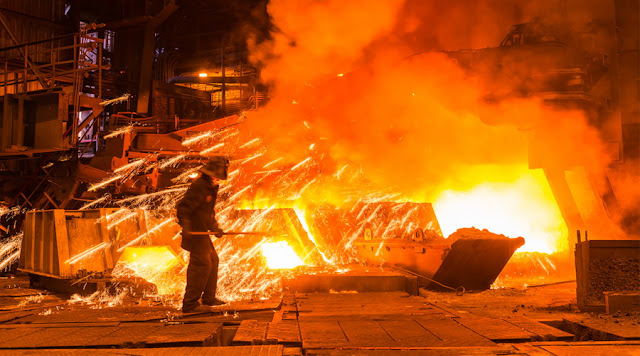Submerged Arc Furnace Principle
Submerged Arc Furnace Principle & Use
The submerged arc furnace is mainly used for reducing and smelting raw materials such as ore, carbonaceous reducing agent and solvent. Also known as electric arc furnace or electric resistance furnace. It mainly produces ferrosilicon, ferromanganese, ferrochromium, ferrotungsten, silicon-manganese alloy and other important industrial raw materials in the metallurgical industry and chemical raw materials such as calcium carbide.
Its working characteristic is to use refractory material as furnace lining and use self-cultivation electrode. The electrode is inserted into the charge for submerged arc operation, using the energy and current of the arc to pass through the charge, and generating energy due to the resistance of the charge to smelt metal.
The load of the submerged arc furnace transformer is continuous and stable, the impedance voltage is low, the number of voltage regulation stages is large, and the level difference is small and the overload capacity is strong. It can be divided into on-load and non-excitation voltage regulation. Generally, the first few stages have constant capacity output, and the latter stages have constant current output.
The SAF equipment is divided into three layers
Level One
It is composed of furnace body (including furnace bottom support, furnace shell, furnace lining), tapping system (including ladle or pot and chartered car, etc.), burn-through device, etc.
Second Floor
(1) Smoke hood.
At present, most of the submerged arc furnaces adopt the closed or semi-closed low fume hood structure, which is environmentally friendly, easy to maintain, and improves the operating environment.
The closed structure can also collect the exhaust gas (the main component is carbon monoxide) generated in the production for comprehensive utilization, and can reduce the heat loss of the circuit, reduce the temperature of the upper part of the electrode, and improve the operating conditions.
(2) Electrode holder.
Most submerged arc furnaces are powered by three-phase, and the electrodes are arranged in a symmetrical position in the middle of the furnace in a equilateral or inverted triangle.
Large-scale submerged arc furnaces generally use electrode materials mixed with anthracite, coke and coal pitch, and the electrodes are self-cultivated and fired in the process of electric furnace smelting.
(3) Short network
(4) Copper tile
(5) Electrode shell
(6) Blanking system
(7) Boiler down machine
(8) Smoke exhaust system
(9) Water cooling system
(10) Transformer of submerged arc furnace
(11) Operating system
The Third Floor
(1) Hydraulic system
(2) Electrode pressing and releasing device
(3) Electrode lifting system
(4) Steel platform
(5) Hopper and circulating cloth car
Other accessories; inclined bridge feeding system, electronic batching system, etc.
The Submerged Arc Furnace principle
The basic task of submerged arc furnace production is to extract metals and other prions from ores or oxides.
The basic principle of metallurgical production in submerged arc furnaces is based on the thermodynamics of selective redox reactions. Its essence is that the oxide of the desired element reacts with the reducing agent to form the oxide of the main element in the desired element and the reducing agent.
Under normal circumstances, in order to solve the problem of low power factor of submerged arc furnace, capacitance compensation is generally used to solve it. Usually, reactive power compensation is performed on the high-voltage side, but since the high-voltage side compensation cannot solve the problem of three-phase balance, and because the inductive reactance of the short network accounts for more than 70% of the inductive reactance of the entire system, the high-voltage side compensation does not reduce the short network. System inductive reactance, improve short-circuit power factor. The purpose of increasing the output of the transformer is only meaningful to the power supply sector.
Therefore, some manufacturers have taken the measures of high and low voltage at the same time reactive power compensation on the newly built furnace to solve the above problems. Compensation at the short grid side can greatly improve the power factor of the short grid side and reduce power consumption. In view of the large reactive power consumption and unbalance of the short grid on the low voltage side of the furnace transformer, and taking into account the effective improvement of the power factor, the reactive power compensation in situ technical transformation is implemented , technically speaking, it is reliable and mature, and economically speaking, the input and output are proportional.
On the low-voltage side of the submerged arc furnace, the reactive power on-site compensation is implemented for the three-phase unbalance caused by the short-circuit reactive power consumption and the inconsistent arrangement length, whether it is to improve the power factor, absorb harmonics, or increase production and reduce consumption. , all have the incomparable advantages of high voltage compensation. However, due to the high cost and harsh working environment, the service life is greatly affected, and the reactive power compensation at the low-voltage side of the short network also brings about an increase in harmonics. Therefore, measures must be taken to suppress the 3rd to 7th harmonics. The investment is increased, the investment recovery period is prolonged, and the follow-up maintenance cost is high, and the comprehensive benefit is not good. Generally only applicable to new furnaces.
Through the above analysis of the submerged arc furnace principle, I believe you have a further understanding. If you want to know more about the professional knowledge of submerged arc furnace, metallurgical industry melting furnace, etc., please continue to pay attention to our blog.
If there has any questions or requests, please feel free to leave a message or email to us.
E-mail: saleswn@hanrm.com / inquiry66@hanmetallurgy.com ( Daisy )
Xi'an Hani Tech Co.,Ltd.



Comments
Post a Comment